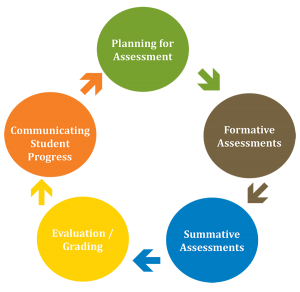
Principle #8
Evaluation and grading must reflect achievement and progress over time in relation to specific learning standards or student goals; evaluation is tied to learning, not behaviour and attitude.
“Honorable intentions don’t justify the use of misguided practices that no longer fit. These traditional grading practices (like averaging, giving penalties, grading everything, and using weighted task types) in fact, are downright wrong given today’s pedagogical landscape and what we now know about instruction and assessment.”
—Schimmer, 2016
Often teachers find that grading interferes with genuine student learning, and that grades, rather than learning, become the primary driver for students, ultimately, creating a disconnect in their learning. To more accurately reflect where students are with their learning and to illuminate what they understand and can do, teachers need to create assessments that are ongoing, varied in nature and administered over the course of the year. These assessments should be designed to closely tie to the curricular competencies and the content of the course, reflecting relevant and authentic experiences for the students that create a clear picture of student strengths and weaknesses.
Teachers strive to ensure the grades students receive are reflective of where students are with their learning; hence, grades should:
- measure learning, not behaviours
- reflect what the student knows, understands and can do
- be used to inform instruction
- be used to improve student learning
- be fair, transparent and equitable for all students
- be organized by the provincial curriculum learning standards
- separate process and content
- be balanced between formative and summative
Assessment for determining grades should not include:
- late penalties
- homework (which is primarily used for formative assessment purposes)
- certain types of group work
- student self assessment
- behavioural issues
- zero marks for missed work (students should be required to complete all work to a minimally accepted standard)
A report card should:
- include a minimum of three pieces of evidence for each learning standard (curricular competencies and content)
- capture the trend in student achievement over the instructional period
- provide a snapshot of student growth over the instructional period
- reflect students’ most consistent achievement
- have a grade/level that reflects greater emphasis to more recent achievement
- not be skewed by extreme scores
- not be a surprise to students or parents
To note:
Teachers’ professional judgement can supersede a calculated grade; however, teachers must ensure the conclusions they reach about student achievement are based on a sufficient number of assessments of learning and reflect student achievement of the intended learning outcomes (Cooper, 2010).
ASSESSMENT CYCLE

TRY THIS
Click here for ideas to try in the classroom
1) Align assessment to specific learning standards.
2) Set up grade book by curricular competencies.
3) Use rubrics to show students what level of achievement required.
4) Have student co create rubrics.
5) Have students maintain a portfolio of their work and submit work they feel meets the required standard.
6) Mark fewer assignments – provide formative feedback on some assignments.
7) Attribute greater emphasis to more recent achievement when determining report card grades/levels.
8) Talk about where students are at on a regular basis so that report cards are not a surprise to any of the parties.
9) Use professional judgement, based on student grade trends, to determine the grade.
10) Do not include behaviour in grade calculations.
WATCH THIS
Click here to watch related video content
Assessment for Learning
Five key strategies for effective formative assessment.
Organizing Grade Books
Ken O’Connor on fixing grade books by organizing by standards.
Teaching Learning Targets in the Classroom
On teaching learning targets. Tip 1: Breakdown standards and use your Learning Targets at the beginning and the end of the lesson. Tip 2: Have your students take ownership of their own learning and the own Learning Targets. Tip 3: Make sure you asses students progression of the Learning Targets.
Professor Hattie on Communicating the Learning Target
How does communicating the learning target impact student learning?
READ THIS
Click here for additional reading suggestions
To learn more, check out these texts:
- Communicating Student Learning on NVSD portal.
- Brookhart, Susan M. & Moss, Connie M. (2012). Learning Targets: Helping students aim for understanding in today’s lesson. Don Mills, Ontario: Pearson.
- Brookhart, Susan M. (2017). How to use grading to improve learning.
- Chappuis, Jan (et al). (2011). Classroom assessment for student learning. Don Mills, Ontario: Pearson.
- Cooper, Damian. (2007). Talk about assessment. Nashville, Tennessee: Thomas Nelson Incorporated.
- O’Connor, Ken. (2011). A repair kit for grading. Don Mills, Ontario: Pearson.
- Schimmer, Tom. (2016). Grading from the inside out. Bloomington, IN: Solution Tree Press.
- Winger, T. (2005). Grading to communicate. Educational Leadership, 63(3), 61-65.
- Wormeli, R. (2011). Redo’s and retakes done right. Educational Leadership, 69(3), 22-26.
